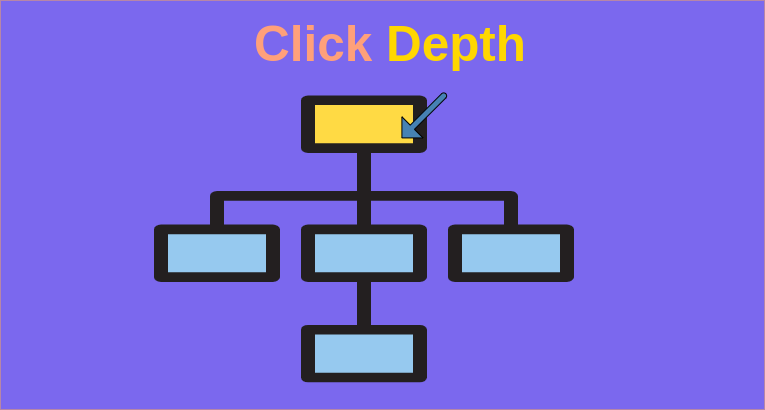
Click Depth - Why and How it matters for a Website’s pagination and SEO
Alot has been written on on-page SEO factors and how they affect search engine rankings. Unfortunately, not every article covering on-page SEO factors lists Click Depth or Page Depth as a ranking factor.
In fact, John Mueller (Webmaster Trend Analyst at Google) has stated that click depth is an important SEO ranking factor—possibly more important than URL structure. According to Mueller, Google evaluates how many clicks it takes from your homepage to reach specific content, and this click path is central to how search engines weigh a page’s importance.
In this article, we’ll go deeper into the concept of Click Depth in SEO and explain how it influences internal linking, pagination, crawl budget, PageRank, and the broader user experience.
Why Click Depth is Crucial for SEO
Click Depth is the number of clicks required to reach a specific page from your homepage. For example, if it takes one click from your homepage to a blog post, that blog post’s click depth is one.
Google’s home page is seen as the central hub—the "cornerstone content"—on your site. Pages further away from this hub are generally considered less important. As SEOs, it should be your goal to make it easy for the users to navigate to the important content of your website from the homepage.
"Pages that are a single click away from the homepage are generally seen as more significant and receive more weight in Google’s rankings. The more clicks it takes, the less important a page appears to both Google and users." — John Muller
Why Should SEOs Care About Click Depth?
- Crawlers favor accessible content: Googlebot is far less likely to crawl pages more than three clicks away from your homepage.
- Deep pages face indexing issues: Pages buried deep (high click depth) are less likely to be found, indexed, or ranked.
- User experience suffers: Visitors are unlikely to click through endless “next” links—friction kills engagement.
To make you understand how exactly does the click depth of a home page affect search rankings, let’s take an example of a 300-page website.
The Anatomy of a 300-page Website and its SEO performance
Imagine having a site with pagination from 1……300. For the purpose of this example, let’s assume they are blog posts with unique content. Here page number 1 is the Home page of the website and 300 is the last page of the website.
Now assume that the site consists of pagination where these pages are connected to a simple “next page” link at the bottom of each blog post. (See image attached below for better understanding)

From a human point of view, the pagination scheme is simple: you click the “next page” link and it takes you to the blog post number 2. You click on the “next page” one more time, it takes you to the number 3. To visit each and every page (say 300 times), you need to keep clicking on “next page” until you reach the page you want to visit. This looks like a holy grail of website pagination. Isn’t it?
From the crawler’s point of view, however, the site looks like this:
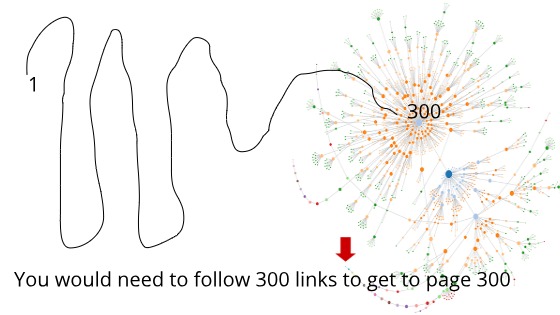
The image above illustrates the visual representation of a discovery path that a search engine crawler has to follow to crawl the whole 300-page website. The tail shown in the diagram is a “tunnel” which represents a long connected sequence of pages that the crawler has to crawl at a time. Note that, for each page, the “next page” link works like navigation to the consecutive page. For a user, it will take 299 clicks to go to the last page of the website. Google sees this as a click depth of 299 clicks, which is very bad for SEO since it offers a poor user experience for your website.
As per Google, the optimal click depth of the home page should not be greater than three clicks. This way the SE crawlers can easily find your website and your website can have a good crawl budget.
Here’s what Google’s John Muller has to say about the importance of Click Depth in SEO,
“What does matter for us ... is how easy it is to actually find the content. So especially if your homepage is generally the strongest page on your website, and from the homepage, it takes multiple clicks to actually get to one of these stores, then that makes it a lot harder for us to understand that these stores are actually pretty important."
“On the other hand, if it’s one click from the home page to one of these stores then that tells us that these stores are probably pretty relevant, and that probably we should be giving them a little bit of weight in the search results as well. So it’s more a matter of how many links you have to click through to actually get to that content rather than what the URL structure itself looks like.”
In essence: If a page needs more than 3 clicks to be reached, it’s performance will be considered as poorly to search engines. Hence, the pages that are deeper in your website silo’s will have issues to crawl as compared to the page of click depth one or two.
If the stats are to be believed, deep pages have a lower page rank because search engines are less likely to find them. Hence, crawling issues will be there. These pages are less likely to perform and rank as compared to the pages that are easily found from the home page.
In our example of the 300 pages website, the last page will have a click-depth of 300. The key takeaway from this kind of website pagination is that the traditional form of “next” and “previous” type of pagination is simply inefficient. Neither it is good for SEO, nor user experience.
If I were to make a list of problems that “Next” and “Previous” kind of pagination has, then here would be my key points:
When a site’s content gets buried deep in the form of links, it sends a poor message to the search engines that the content is not important for users. Hence, bad SEO. Even worse, if any of the links among “next” and “previous” returns an error, crawlers will not crawl the pages that are deep inside the pagination. Website visitors won’t click up to the 300th page or even lesser than that. That’s a bad user experience. So, how do we improve the click depth of a 300-page website?
Enter the Midpoint link pagination scheme
Traditional “next/previous” pagination, while user-friendly for browsing, is an SEO pitfall. If your site has 300 blog posts spread over 300 sequential pages, it might take hundreds of clicks to reach the last page. Crawlers see this as a click-depth of 299, which is terrible for SEO.
The Drawbacks of Deep Pagination
- Important pages become invisible to search engines.
- Error-prone navigation: If a link along the chain breaks, everything after it becomes unfindable for crawlers.
- Poor user experience: No one is clicking “next” hundreds of times.
In our 300 page website example, pagination for the homepage looks like this:
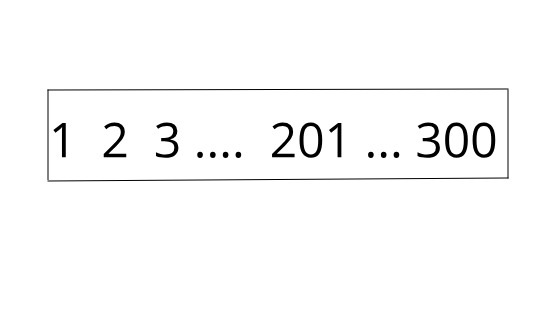
In the above image, 201 is the midpoint of the pagination and it lowers down the click depth from 300 to only a few clicks. What’s more, this scheme makes it possible for a crawler to navigate from any page to any other page in just a few steps.
Here’s the crawl chart for the Midpoint pagination strategy:
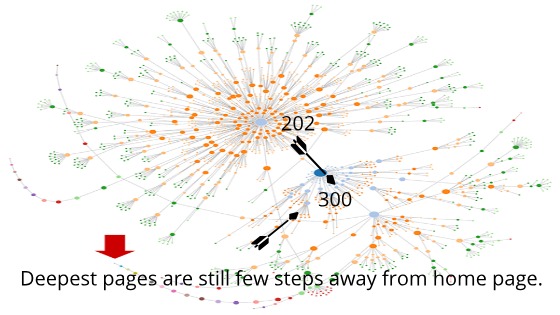
Notice how easily your user will be able to go to the last page of your website from page no. 201. This leads us to an incredible level of crawlability improvement as compared to the previous “next” and “previous” pagination scheme.
What is the relation between Click Depth and Page Rank?
If a website (or Homepage) has a poor Click Depth then it can adversely affect search engine rankings.
The reason is simple: Google will not crawl the pages that are linked far away from the homepage. As a result, these pages won’t make their way to index. This will impact the rankings as there is little to no traffic on the pages.
The relationship between Click Depth and Page Rank is directly related as both of them are highly important to evaluate a page’s importance. The Page Rank algorithm does this by counting the quality and number of links to the page. On the other hand, Click Depth does this by automatically influencing the Page Rank depending on the number of clicks taken by the google bot to find the deep-linked pages from the website homepage.
So, how do we improve the Page Rank of the 300-page website?
The answer to this question lies in the internal linking graph optimization scheme. Your website, irrespective of the number of pages, can be optimized for Page Rank by internally linking the most important pages of your website.
Kevin Indig, VP SEO & content at G2.com, has written a really awesome article on the internal linking graph optimization scheme of a website that has 1000+ pages. Kevin’s article illustrates a TIPR model that dives deep in a robin-hood fashion to improve the page rank of poor pages of a website by linking them internally from stronger pages.
What are some strategies to improve the Click Depth of your website?
To improve the click depth of a website, all you need to do is to make all your pages accessible within three to four clicks from the homepage.
For starters, it can be done by visualizing your website as a tree graph to understand the overall structure of the website. (See the image attached below for reference)
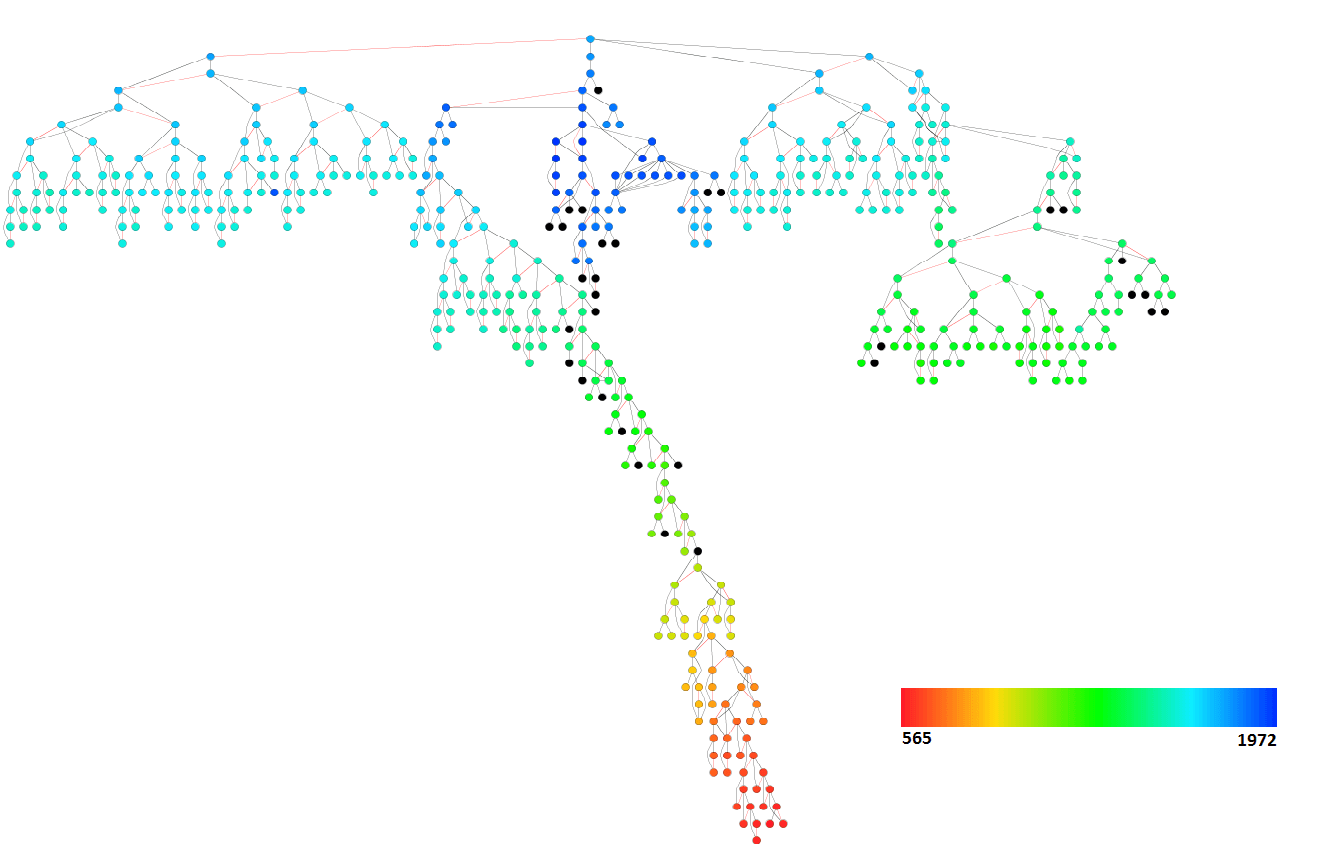
Notice how efficient it becomes to understand the website structure if we visualize the tree graph and put it on a paper. In large websites, you can improve the Click Depth by internally linking the poorly performed pages to the useful pages.
Internal linking improves your website’s Click Depth by:
Lowering the number of clicks it takes for a user to reach the page, thereby facilitating the crawler job Distributing the page rank throughout the website by linking poorly-performing pages to top-performing pages Decreasing the bounce rate since your users can easily navigate and access the linked pages Apart from internal linking, other strategies to improve the click depth of a website include:
Sidebars to link top-performing pages and articles Breadcumbs to navigate the previous pages and home-page
Conclusion
Click depth should be a front-and-center consideration when designing site architecture, planning pagination, and allocating crawl budget. Keeping your vital content within 2–3 clicks of your homepage benefits SEO, user experience, and business performance.
Remember: Both search engines and humans reward sites that make important content easy to find. The shorter the click path, the better your chances of higher rankings, faster indexing, and deeper engagement.
Have other tactics for handling click depth on a massive website? Share your thoughts in the comments!
I enjoy writing about things I learn & I know, building scalable Digital Marketing campaigns, and learning a bit of web development, side-by-side.
When not in front of a screen I like to listen music, play guitar, read books, and binge-watch anime/ series.










